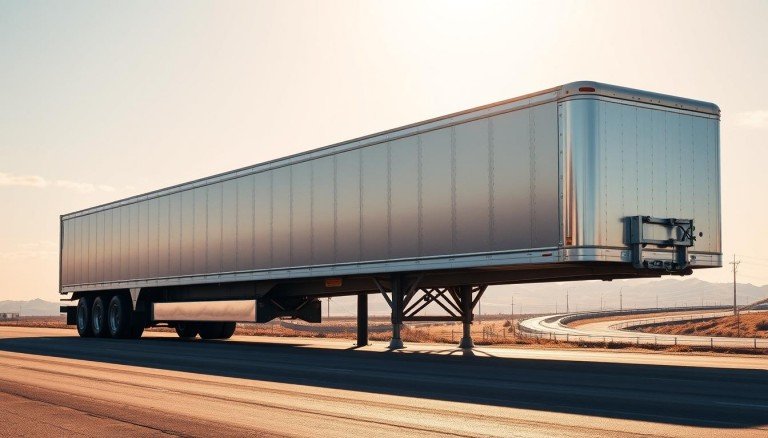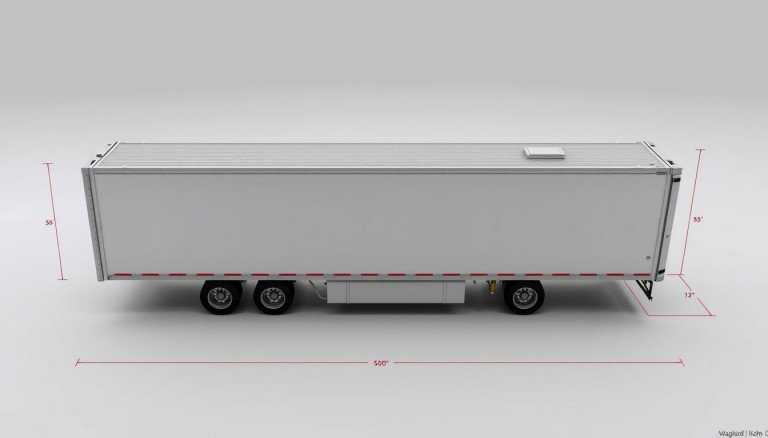The road to success is dotted with many tempting parking spaces.” – Will Rogers. This quote highlights the importance of 18 wheeler trailer sizes in the freight world. Knowing the sizes is key for moving cargo efficiently and safely.
This guide covers the different sizes and specifications of semi-truck trailers. You’ll learn about overall lengths typically ranging from 70 to 80 feet, including the tractor, and the various trailer types. Understanding these details helps professionals comply with regulations and optimize their operations.
Table of Contents
Understanding Semi-Truck Dimensions
Knowing the size of semi truck trailers is key in the trucking world. It’s important to pick the right trailer size to carry more and follow the rules. The right size helps avoid fines and keeps everyone safe on the road.
The length of a tractor trailer can change a lot. It depends on the trailer type and how much it’s carrying. Knowing this helps truckers plan their trips better.
The Importance of Knowing Trailer Sizes
Trailer sizes affect how well trucks move goods. When drivers and companies know their trailer sizes, they can carry more safely. This makes them more productive and helps keep the roads safer.
Knowing the exact size of a semi truck trailer also saves money. It keeps them from getting fined for carrying too much or being too big. This makes moving goods smoother and easier.
Overview of Common Types of Trailers
The trucking world uses many different trailers. Each one is made for a special job. Here are some common ones:
Dry Van Trailers: Usually 53 feet long, 8.5 feet wide, and 13.5 feet tall.
Refrigerated Trailers: Also 53 feet long, perfect for cold goods.
Flatbed Trailers: Range from 48 to 53 feet long, 8.2 to 8.5 feet wide. They’re easy to load and unload.
Tanker Trailers: Can be 40 to 53 feet long. They’re for moving liquids.
Lowboy Trailers: 40 to 53 feet long, 20 to 30 inches tall. They carry heavy stuff.
Typical Dimensions of an 18 Wheeler
The size of an 18-wheeler is key in the logistics and transportation world. Knowing the average sizes helps with following rules, planning loads, and being efficient. The typical sizes guide operators in picking the right trailers, boosting performance.
Average Length, Width, and Height
A standard 18-wheeler is typically 70 to 80 feet long overall. The trailer itself is often 48 to 53 feet long, while the tractor unit adds another 20 to 25 feet. The standard width is 8.5 feet (102 inches), excluding additional allowances for safety features like mirrors, and the height is approximately 13.5 feet.
Weight Capacities for Various Trailer Types
The weight a trailer can carry is crucial in choosing the right size. The total weight, including the trailer and tractor, can’t be over 80,000 pounds for highways. Different trailers can carry different amounts, like:
Flatbed trailers: Up to 48,000 pounds of payload.
Lowboy trailers: Typically 45,000 to 85,000 pounds of payload, or over 100,000 pounds with special permits.
Step-deck trailers: Typically 40,000 to 48,000 pounds of payload, depending on configuration.”
Knowing these weight limits helps operators pick the right trailer for their job. This ensures they follow the law and are efficient.
18 Wheeler Trailer Size Specifications
Knowing the size of 18-wheeler trailers is key for safe and efficient transport. This part looks at length, height, and width. Most trailers, like dry vans and refrigerated ones, are 48 to 53 feet long. It’s vital to remember that trailers can’t be taller than 13.5 feet to fit under bridges and overpasses.
The width of a truck trailer is always 8.5 feet. This includes space for safety features like mirrors, which might add a bit to the total width.
Length and Height Specifications
Following strict length and height rules is crucial for 18-wheelers to move smoothly. Here’s a quick guide on trailer types and their sizes.
| Trailer Type | Length (ft) | Height (ft) |
|---|---|---|
| Flatbed | 48 – 53 | 13.5 |
| Dry Van | 48 – 53 | 13.5 |
| Refrigerated | 48 – 53 | 13.5 |
| Step Deck | 48 – 53 | 13.5 |
| Lowboy | 48 – 53 | 1.5 – 2 |
Heights listed are maximum overall heights, including cargo where applicable. Lowboy trailers have a lower deck height for oversized loads
Width Considerations for 18 Wheelers
Knowing the width of 18-wheelers is important for road safety. The maximum width is 8.5 feet. Some places might allow a bit more for safety features.
Standard maximum width: 8.5 feet (102 inches)
Some states have additional allowances, ensuring necessary clearances for side mirrors and attachments.
Regulations may also dictate width limitations for certain cargo types, ensuring road safety.
Types of Trailers and Their Dimensions
Knowing the different types of trailers and their sizes is key for trucking pros. Each trailer type has its own role and size, affecting how it’s used. Here’s a look at common trailer types, their sizes, and weight limits.
Flatbed Trailers
Flatbed trailers are ideal for transporting heavy and oversized loads. They are commonly available in lengths of 40, 45, 48, and 53 feet, with 48 feet being the most standard. The width is typically 8.5 feet, and the maximum height, including cargo, is 13.5 feet. They can carry up to 48,000 pounds.
Dry Van Trailers
Dry van trailers are the most common, making up 61% of U.S. trailers in 2021. They’re 53 feet long and can hold 42,000 to 45,000 pounds. Their closed design keeps cargo safe from the outside, fitting many transport needs.
Refrigerated Trailers
Refrigerated trailers, or reefers, are key for moving goods that need to stay cool. They’re usually 53 feet long, carrying 42,000 to 45,000 pounds. This keeps food and other perishables fresh during transport.
Tanker Trailers
Tanker trailers are vital for moving liquids like fuels, chemicals, or food-grade items. Their sizes vary based on the liquid and its weight. The max legal cargo weight depends on the truck and road rules.
| Trailer Type | Common Lengths | Max Weight Capacity |
|---|---|---|
| Flatbed Trailers | 24, 40, 45, 48, 53 feet | 48,000 lbs |
| Dry Van Trailers | 53 feet | 42,000 – 45,000 lbs |
| Refrigerated Trailers | 53 feet | 42,000 – 45,000 lbs |
| Tanker Trailers | Varies (depends on the liquid) | Varies (depends on content) |
State Regulations Impacting Trailer Sizes
Knowing the rules on trailer sizes is key for those moving goods across states. Each state has its own rules for how big and heavy semi trucks can be. Understanding these differences helps avoid fines and keeps operations smooth.
Understanding Interstate Regulations
Interstate rules set a basic standard for truck sizes and weights. The top weight limit for trucks is 80,000 pounds. This includes rules for each axle, like 20,000 pounds for single axles and 34,000 pounds for tandem axles.
Even though federal law sets a base, states can have stricter rules. This is because of local roads and safety needs.
Federal law sets a maximum trailer length of 53 feet, but overall tractor-trailer length typically ranges from 70 to 80 feet, with some states allowing longer combinations (e.g., turnpike doubles up to 100 feet) on designated routes.
Variations in State Regulations
Every state has its own rules for semi trucks, fitting to local needs. Texas lets trucks be longer, while others limit them to 60 feet. Some places, like cities or counties, have their own rules, like no trucks over 14,000 pounds in homes.
There are about 20 state routes with special truck rules. These rules can be based on weight, length, or what’s being carried. This shows how important it is for truckers to know the rules in each state they drive in.
Factors Influencing 18 Wheeler Dimensions
Knowing what affects trailer size is key for better transport planning and safety. The tractor type is a big factor, as it changes both length and design.
Type of Tractor and Its Impact
The tractor type greatly impacts an 18-wheeler’s size. Day cabs are shorter than sleeper cabs, affecting the truck’s size. A standard semi cab is between 245 to 265 inches long. The total length of a tractor-trailer can be 70 to 80 feet.
Knowing these details helps pick the right trailer. It must fit the tractor’s size and meet weight limits.
Impact of Load Type on Dimensions
Load type also affects trailer size. Different loads need special trailer designs. For example, flatbed trailers are 48 or 53 feet long.
Refrigerated trailers, or reefers, can carry up to 45,000 pounds. They are 48 to 53 feet long. Specialty trailers for unique cargo can carry up to 200,000 pounds. Choosing the right trailer for the load ensures safe transport and efficiency.
Benefits of Knowing Your Trailer Size
Knowing your trailer size has many benefits for moving goods. It helps plan how to load things better and carry more. It also makes sure you follow weight rules and drive safely.
Improved Efficiency in Hauling
Knowing the right trailer size makes hauling better. It lets drivers carry more stuff in one trip. This saves fuel and time, cutting down costs.
For example, a gooseneck trailer is great for heavy loads. It keeps things stable and saves time and money on routes.
Ensuring Road Safety and Compliance
Knowing trailer sizes is key for safe driving. The right size trailer lowers accident risks. Mismatched trailers cause 20% more accidents.
Following rules keeps everyone safe. It makes sure you follow laws and drive safely for all.
Conclusion
Understanding 18 wheeler trailer sizes is key for the transportation industry. The standard size, like the 53-foot trailer, helps with efficient routes and follows federal rules. This ensures operations are smooth and legal.
Knowing these details helps in planning logistics and using assets well. It’s not just about following rules; it’s about making operations better.
Regulations also shape the size and safety of semi-trailers. Staying in line with state rules is crucial for safety and keeping operations running right. This guide is a great resource for those in the trucking world.
Being aware of trailer sizes and rules boosts transport safety and efficiency. This guide shows how important it is to make informed choices in trailer transport.
FAQ
What are the standard dimensions of an 18 wheeler trailer?
A standard 18-wheeler, including the tractor, is typically 70 to 80 feet long. It’s about 13.5 feet tall and 8.5 feet wide.
How does trailer size affect payload capacity?
Knowing the trailer’s size helps carry more cargo. This ensures you follow the rules and avoid fines for oversized loads.
What are the common types of trailers used in freight transportation?
You’ll find dry vans, flatbeds, refrigerated trailers, and tankers. Each is designed for different cargo needs.
What are the weight limits for 18 wheeler trailers?
18 wheeler trailers can’t weigh more than 80,000 pounds. The exact weight limit depends on the trailer type.
How do the type of tractor and load affect trailer dimensions?
The tractor type, like a day cab or sleeper cab, can change the trailer length. The cargo type also affects the trailer design needed.
What advantages come with understanding trailer sizes?
Knowing trailer sizes improves loading efficiency. It also increases payload capacity and reduces accident risks from oversized loads.





